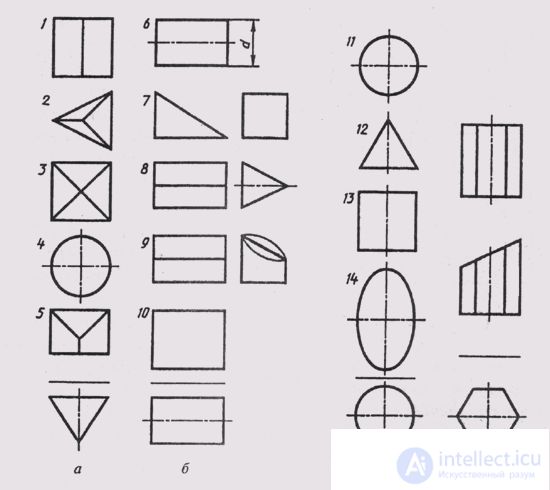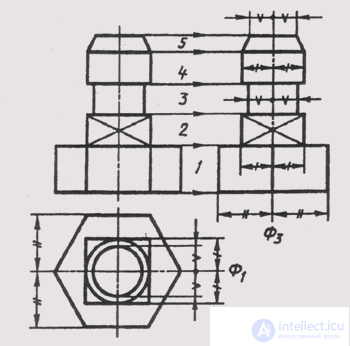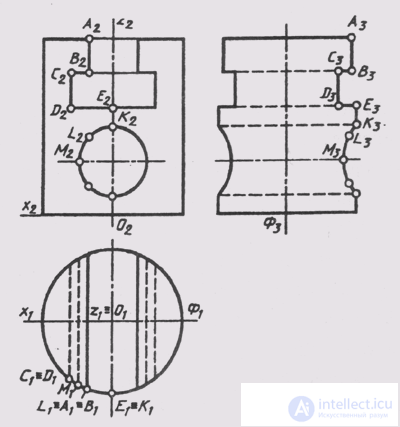Lecture
In order to successfully carry out and read the drawings, one must learn to build a third image (usually the left view) of an object from its two image data — the main view and the top view, which are specified in the drawing.
First of all, you need to find out the shape of individual parts of the surface of the depicted object. To do this, both of the specified images must be viewed simultaneously. It is useful to keep in mind what surfaces correspond to the most common images: a triangle, a quadrilateral, a circle, a hexagon, etc.
The top view in the form of a triangle can be represented (Fig. 170, a): triangular prism 1, triangular 2 and quadrangular 3 pyramids, cone of rotation 4.

Fig. 170
The image in the form of a quadrangle (square) can have in the top view (Fig. 170, b): a cylinder of rotation 6, a triangular prism 8, a quadrangular prism 7 and 10, as well as other objects bounded by planes or cylindrical surfaces 9.
The shape of the circle can be in the top view (Fig. 170, c): ball 11, cone 12 and cylinder 13 of rotation, other surfaces of rotation 14.
The top view in the form of a regular hexagon has a regular hexagonal prism (Fig. 170, d), bounding the surfaces of nuts, bolts and other parts.
Having determined the shape of individual parts of the surface of an object, it is necessary to mentally present an image of them in the left view and the entire object as a whole.
To construct the third type, it is necessary to determine which lines of the drawing it is advisable to take as the baseline for the report of the dimensions of the image of the object. As such lines, usually used axial lines (projections of the planes of symmetry of the object and the projections of the planes of the bases of the object). Let us analyze the construction of the left view using an example (Fig. 171): from the data of the main view and the top view, construct the left view of the depicted object.
Comparing both images, we establish that the surface of the object includes the surface: regular hexagonal 1 and quadrangular 2 prisms, two cylinders 3 and 4 of rotation and a truncated cone 5 of rotation. The object has a frontal plane of symmetry F, which is conveniently taken as the base of the report of dimensions for the width of individual parts of the object when constructing its left-side view. The heights of individual sections of the object are counted from the lower base of the object and are controlled by horizontal lines of communication.
The shape of many objects is complicated by various cuts, cuts, intersection of

Fig. 171

Fig. 172
putting surfaces. Then first you need to determine the shape of the intersection lines, and you need to build them by individual points, introducing the designations of the projections of the points, which after performing the constructions can be removed from the drawing.
In fig. 172, a left-side view of the object is constructed, the surface of which is formed by the surface of a vertical cylinder of rotation, with a T-shaped notch in its upper part and a cylindrical hole with a frontally projecting surface. The base planes are the lower base plane and the frontal plane of symmetry F. The image of the L-shaped notch in the left view is constructed using the points of the contour of the notch A B, C, D and E, and the line of intersection of the cylindrical surfaces is using the points K, L, M and im symmetric. When constructing the third type, the symmetry of the object relative to the plane F. is taken into account.
Comments
To leave a comment
Descriptive Geometry and Engineering Graphics
Terms: Descriptive Geometry and Engineering Graphics